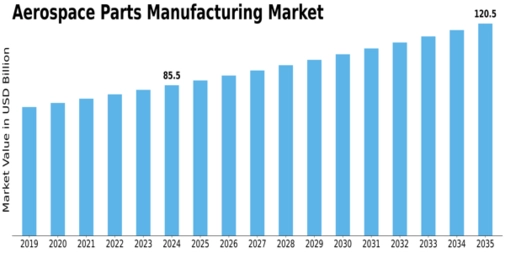-
Новости
- ИССЛЕДОВАТЬ
-
Страницы
-
Группы
-
Мероприятия
-
Статьи пользователей
-
Offers
-
Jobs
-
Courses
Forecasting the Future: Growth Trends in Aerospace Parts Manufacturing Market and Size Projections

When discussing the Aerospace Parts Manufacturing Market, it’s critical to understand who’s flying ahead and how competitive dynamics shape growth, size, share and industry trends. With a projected market size of USD 120.5 billion by 2035, the battle for leadership in parts manufacturing continues.
Market Overview & Growth Context
The Aerospace Parts Manufacturing Market, valued at USD 82.9 billion in 2023 and expected to reach USD 120.5 billion by 2035 (CAGR 3.17%), presents a sizeable industry segment for aviation, defense and space. Within that, companies manufacturing structural, engine, electrical and interior components operate in a competitive battleground of innovation, materials, licensing and manufacturing methods.
Who Are the Key Players?
Leading companies profiled in the Aerospace Parts Manufacturing Market include Lockheed Martin, General Electric, Airbus, Boeing, Honeywell International, Northrop Grumman, Raytheon Technologies, MTU Aero Engines and Safran. These market players drive growth by investing in advanced materials, additive manufacturing, supply-chain optimization, and partnerships for sustainable aerospace manufacturing.
Competitive Landscape & Industry Trends
In the Aerospace Parts Manufacturing Market, competition is fueled by factors such as:
-
Innovation in manufacturing processes (3D printing, automation)
-
Adoption of lightweight materials (composites, titanium) for performance improvements.
-
Expansion of aftermarket services and OEM manufacturing for both commercial and military demand.
-
Strategic alliances, mergers and acquisitions to enhance manufacturing capabilities and geographic reach.
The interplay among these factors determines market share, growth potential and the overall competitive outlook for the Aerospace Parts Manufacturing Market.
Long-Tail & Competitor Keywords to Track
To fine-tune content or competitive intelligence, long-tail keywords such as “leading aerospace parts manufacturing companies 2030,” “aerospace parts manufacturing market competitive landscape analysis,” “OEM vs aftermarket aerospace parts manufacturing key players,” and “aerospace parts manufacturing market growth strategy for competitor companies” prove useful. Similarly, competitor keyword sets like “aircraft component suppliers manufacturing market share,” “defense aerospace parts manufacturing players,” and “commercial aviation parts manufacturing vendor list” help digital and market research efforts.
Strategic Implications for Industry Participants
For companies operating in the Aerospace Parts Manufacturing Market, watching the competitive landscape is vital. Those who invest in advanced manufacturing techniques, diversify materials, expand into emerging regions, and integrate sustainability will likely capture a larger share of the market. With the forecast to 2035 in mind, staying ahead of trends, aligning with demand from commercial aviation, military and UAV segments, and collaborating across the value chain will define winning strategies.
Closing Thoughts
In the Aerospace Parts Manufacturing Market, size and growth are significant—but who commands that growth is equally important. As companies jockey for position, the ones prioritizing innovation, regional presence, materials leadership and end-use diversity will shape the future of aerospace parts manufacturing. Keeping an eye on key players, competitor moves and industry trends will be essential for thriving in this dynamic market.
- Art
- Causes
- Crafts
- Dance
- Drinks
- Film
- Fitness
- Food
- Игры
- Gardening
- Health
- Главная
- Literature
- Music
- Networking
- Другое
- Party
- Religion
- Shopping
- Sports
- Theater
- Wellness


